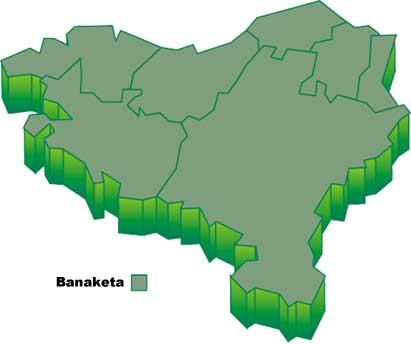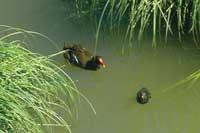Gallineta carrizal

According to most manuals, the rooster is a shy, terrible and fleeting bird. There are those who think, moreover, that when discovering some danger is able to dive under the water until the enemy moves away, showing only the tip of the respiratory peak. All this can be credible, of course, but... how is it that you can see that you breed at the height of the bus station of Toulouse with total tranquility? for example. How amazing! Is it not a terrible contradiction to fear and live in the center of the people and in the public space? It may be so, but some animals that have always escaped the human being can be seen quietly in places that respect.
Large towns and cities can be one of the clearest examples. Thus, it is increasingly normal to see blackbirds, ducks, squirrels… or chickens in environments conquered by man. As we have said in Toulouse, hens can appear in most wetlands with conservation vegetation, discovering tranquility.

The uroyl ( Gallinula chloropus) is a sturdy bird the size of the partridge. The name “uroilo” in Basque indicates that this wetland bird has a kind of hen: long legs, short tail and rounded appearance. Due to these special features, it is an easily recognizable bird and if mixed with some other, it can be mixed with the copenhagen ( Fulica atra), although its size is quite larger. The color of the pen is very dark on both sides, but unlike that of the co-pilot, the tail of the rooster is white on its bottom and has a white footprint on the ribs.
In addition, as the name suggests, it has the beak and the white buds and the red hens, with the yellow tip of the beak. The green-yellow legs of the hens, on the other hand, have a red footprint on the tibia like a pant. Because they have no membrane on their fingers, they cannot swim very fast, and thanks to these long fingers, they move freely between reeds and tree branches, or without sinking into the surface waters and mud. The description is valid for both female and worm, but the young are more brown and replace the red shield with green.
The movement of the rooster, on the other hand, is rare. In every step on foot or swimming, the head dances forward and backward. In turn, it constantly shakes the tail, which by its underlying white color is spectacular. On the other hand, despite having a body of about 33 cm, it has a fin width of about 45-50 cm, relatively small, so the rooster is not a big flying.

To get out of the water, on the water, it makes it square to catch speed and take off. And it flies with the legs in a very peculiar way, hanging at the beginning and stretching back, longer than the tail, which appear clean. Normally it goes down after a short flight without great heights. Therefore, and if it detects danger, rather than flying, the chicken coop prefers to run into hiding, which makes it perfectly.
Everyone who has worked on it knows that it is difficult to see animals in the middle of the reed and even more difficult birds like the rooster. However, the “Kit”, the “kek-ks”, the “kas” and other sounds of difficult transcription can be listened to with attention.
After the day in the shelter of the wetland, you can go to the fields at night in search of pastures. Despite being mainly vegetarian (or phytophagous), the rooster also eats aquatic animals and some writers have considered it omnivorous. Occasionally you can steal eggs from some nest or chickens. Unlike coquetazuria, this rash is something solitary and we only see it grouped from 3 to 4. On the other hand, not needing a large house, the existence of a canal, swamp or freshwater well is enough to live them, provided there is enough vegetation to store them. They often manage to live and raise contaminated areas and adapt perfectly to places transformed by man. This adaptability makes its distribution wide.
Cosmopolitan bird that lives in almost everyone except in Australia and/or polar areas. In Europe it extends from southern Sweden and Finland to the Mediterranean, being very common in the Iberian peninsula. In Euskal Herria it is visible in most regions, but always on land of less than 1,000 meters. In some places, such as the Zadorra, Bayas, Aragón, the Arga and the Ega, in the lower part of the rivers and in the vicinity of the Ebro, they are very abundant, although in other small wetlands can appear the rooster. As for the migration trend, we can say that most of the hens in the area are sedentary, but towards autumn-winter can also be associated those from the north in their wetlands.

Playback will begin by March-April. To begin with, they usually build a nest among the wetland plants. In most cases it is a compact floating structure of aquatic and dry plants, although sometimes it can happen that some other nest is restored or built in the tree. In it, the female will alternate between 4 and 10 roasted eggs and with the male for 19-22 days. These eggs are usually 45 mm, light brown and decorated with brown and red marks. After those days the chickens dressed in black down begin to be born.
Being nidifuges, by fulfilling a maximum of 2-3 days in the nest, they learn to swim quickly. It takes 5 weeks to learn to fly, half a year to appear to adults and one year to reach sexual maturity. In most cases, parents will also remove the second chitazo, and in some cases the third, and in these txitos the older ones help to grow the younger brothers. And to enjoy these magnificent shows, it is not necessary to go far. That slow well of your people may be enough for the chickens, provided you leave them in peace.
Species: Gallinula chloropus |





